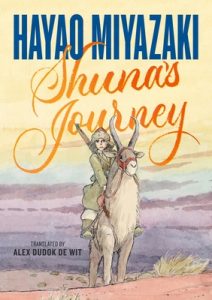 Shuna’s Journey
Shuna’s Journey
Written and illustrated by Hayo Miyazaki
Trans. from Japanese by Alex Dudok De Wit
First Second, 2022, 160 pp (unpaged)
ISBN: 978-1250846525
“At the bottom of an ancient valley carved out by a glacier, there was a small kingdom which time had abandoned” (p. 1). These opening words frame a two-page spread showing a tiny kingdom in a valley overwhelmed by mountains and cliffs. In this visually lush fantasy, a prince goes on a dangerous quest for a golden grain that could save his people from poverty and starvation. When a mysterious traveler presents Shuna with a few seeds from a secret land, he sets off to find the source of the grain, living seeds that can grow crops for generations to come. Along the way, he meets a proud refugee girl who is being held in captivity, freeing her and continuing on his quest. He sees many unbelievable sights, eventually finding the hostile Land of the God-Folk but sacrifices his memory and speech for the grain. When he returns, he relies on the strength and kindness of Thea and her sister to bring back his memory and save his kingdom.
In a mix between a manga novel and a picturebook, full-page watercolor illustrations are intermixed with panels to encourage readers to linger over an image or to read quickly to follow the action-filled story in manga style, right-to-left. The written narration is placed outside or along the edges of panels, allowing readers to immerse themselves in the breathtaking visuals.
Afterwords from the author and translator provide insights into the story’s roots in a Tibetan folktale and the connections between this book and Miyazaki’s later animated works. These cultural roots are reflected in the visual elements in the panels, such as the embroidered clothing, rooms with painted murals and woven tapestries, and towering statues. The reimagined tale explores themes of environmental degradation and acts of kindness within a cruel and dehumanizing world. The tale is full of adventure and mystery in an imagined world where humans barter for dead seeds that can only be consumed, instead of living seeds that can sustain life. Messages of courage and hope fill the reader through the appearance of green seedlings, providing the possibility of a different future.
One interesting pairing with this book is The Wanderer by Peter Van den Ende (2020), a 90-page visual narrative in which a paper boat navigates an intercontinental voyage through marvelous and oppressive worlds, ending with the emergence of a human figure. Another pairing is with fantasies such as The Barren Grounds by David Robertson (2020) in which two Cree children go through a portal into a wintry land where a Misewa community of animal beings need their help to survive. Dystopias provide another possibility, such as Daniel José Older’s Flood City (2021) in which humans battle for the last habitable place left above the waters covering Earth. Finally, realistic fiction, such as Alan Gratz’s Two Degrees (2022), can connect this fantasy with our current world. In parallel narratives, three children endure climate change disasters–a wildfire in California, a close encounter with a hungry polar bear in Canada, and a massive hurricane in Florida.
Hayo Miyazaki is a legendary Japanese artist, animator, director, and founder of Studio Ghibli. He is most well known for his animated film masterpieces, such as “Spirited Away,” “Princess Mononoke,” and “My Neighbor Totoro.” These films feature Miyazaki’s detailed animations to tell stories about characters who journey into supernatural worlds on dark and dangerous journeys, a similar pathway as Shuna’s Journey. Miyazaki grew up drawing and dreamed of becoming a manga artist. His conservative parents opposed his ambitions, wanting him to become a business executive. While he studied economics in college, he also met with a children’s literature study group. They read Western classics, such as books by Jules Verne and Frances Hodgson Burnett, leading him to a career in animation and storytelling around adventures, gardens, and strange encounters. His worlds are places where nature, animals, gods, and humans interact. Shuna’s Journey was originally published in 1983 in Japanese but not translated into English until 2022.
The translator Alex Dubok de Wit is a British freelance animation journalist. His love of animation and respect for Hayo Miyazaki led him to take on the translation of the book from Japanese to English. His knowledge of Japanese animation and respect for visual image allowed him to capture the beauty and brevity of Miyazaki’s written word, keeping the visual images at the forefront.
Readers will return from this voyage into a mythic realm of beauty and heartbreak challenged to consider how they might work for a better future.
Kathy G. Short, University of Arizona, Tucson
© 2023 by Kathy G. Short

